
Describe the object's motion as accurately as you can ...
Why does it fall?
Why is it accelerated?
Does it fall downward?
Why is this a strange description?
| Newton's laws of motion | Gravitation | Tides and tidal forces | Day and Night |
| Seasons | Moon's Phases | Eclipses | Solar System Model |
| Kepler's laws | Retrograde Motion | Coordinates and Time | Coriolis effect |
Topics in Italics include links to animations. Topics in bold letters are very, very important (they'll be on the midterm). My goal is that you will never forget the CORRECT explanation for Gravitation, Day and Night, Seasons, Moon's Phases and Eclipses. If you, Heaven forbid, forget the correct explanation, please stay mum when somebody asks you about it, rather than blurting out the wrong explanation.
I teach many of the following concepts like our Moon's phases,
eclipses, seasons, the Sun on Mercury, Venus' phases by emphasizing
that there are Two Viewpoints.
Here is an example: We stand on Earth (that's one viewpoint) looking at
the Sun every hour or two from sunrise to sunset. We conclude that the
Sun
orbits the Earth. That's true from our viewpoint. And don't be
outraged,
most people before Copernicus believed that. In fact, that's what we
see,
too!
Of course, we know better because we put ourselves at the other
viewpoint, which is outer space. From there we see that the Earth
rotates once on its axis during 24 hours. And we see that a region on
Earth enters sunlight and several hours later leaves it. From that we
can understand why the Sun appears to move across the sky (as seen from
Earth, our first viewpoint).
So keep in mind that you should try to see events like an eclipse from
two different viewpoints. It makes it easier to understand what's going
on.
I don't think that there are any true examples - because forces are present all the time. But we can come up with some examples that approximate the first law: rolling bowling ball, flying bullet and thrown ball (really?), resting ball, astronauts in Space Shuttle (really?), Voyager 2, ...
2. Forces produce an acceleration with the (inertial) mass impeding the acceleration:
F1 + F2 + ... = m a
It is very important to notice that no Force is necessary to keep an object in motion (see Newton 1). Forces instead change the motion of an object by making it faster, making it slower, or changing its direction of motion.
Examples: toy car with spring, walking, lifting, shoot bullet, pulling cart on air track, ...
The reason why people confuse this - needing a force to keep a car at constant speed - is that in such a situation there is a force, namely friction, that slows the car down (N 2), so there must be a force, namely the engine, to speed it up again (N 2). If the speed remains the same, both forces cancel each other which means that the acceleration is zero (N 2). You see that one force has to make up for another. It has nothing to do with Newton 1 - with the only exception of driving on a completely icy and level road where one could turn the engine off and can truly notice that the car skids along at constant speed without needing any extra force.
3. For every force there is an equal and opposite force - Action and Reaction.
An object acting upon second object with a force F experiences the same force F but in the opposite direction. The important thing to remember is that one force acts on object Y and its reaction force acts on the first object X. This describes another situation of what Newton 2 says where forces of interest act on one object only.
Examples: when fist hits nose, nose is hurt, fist is hurt; recoil of a gun; sprinkler system; Earth attracts Moon, Moon attracts Earth; Sun attracts Earth, Earth attracts Sun; ...
The reaction force is the same! Earth
really does attract our Sun with the same force (but opposite
direction) as our Sun
attracts us. Of course we only perceive Earth as orbiting our
Sun: since
our Sun's mass is 300,000 larger than Earth's, its acceleration
is
300,000 times smaller (N 2)!
Appendix
Weight: Weight is a force, measured in units of Newtons
or Pounds. Weight is produced by a gravitational force (e.g.
Earth,
Moon). Weightlessness would strictly mean that no gravitational
force
is acting upon an object. Astronauts in the Space Shuttle do feel
the
Earth's gravitational force, their weight being perhaps 95% of what it
is
on Earth (depending on Shuttle's altitude). But they're in
free-fall
(with the Shuttle) all the time, therefore they feel weightless -
although
it's not a correct description.
The motions in the solar system (and everywhere in the universe) are governed by
Newton's Law of Gravitation
F = G m1 m2 / r2
m1 and m 2 are two masses at a distance r from each other. They are attracted towards each other by the force F . The gravitational constant G = 6.67 10 -11 is very small, indicating that for small masses the gravitational force is tiny, but for large masses, such as planets, moons, stars and galaxies (conglomerates of billions of stars) it is the governing force.
Any (and I mean ANY!) two Bodies attract each other due to Gravitation.
[It's not a good idea to rely on gravitational attraction if you want to date somebody. The two of you are gravitationally attracted, but with such a small force that it becomes negligible.]
Again, the Force between them depends on their respective Masses and inversely on the (square of their) separation Distance.
- Explanation and reasoning of the Law of Gravitation as applied to
orbits is tied in with Newton's Third, Second, and First Laws of
Motion.
- Model of
Cavendish balance
"Only Newton could see that the Moon is just as much falling as an apple is falling from a tree."
(quotes from Tom Folley's "The Book of the Moon")
 |
An object is dropped from a height of 5 to 6 feet.
Describe the object's motion as accurately as you can ... Why does it fall? Why is it accelerated? Does it fall downward? Why is this a strange description? |
| (Notice the LEGO figures that are placed on
the globe.)
Or does it fall towards Earth? Why is this description more precise? Why towards Earth? Is there anything special about Earth? |
 |
Note the Newton's law of Gravitation says "mass" - it doesn't say
"Earth". Why should it say Earth? Is the Earth a spiritual
being or a magician that says "fall towards me"?
Default conclusion: any mass must exert a gravitational force!
Why then is Earth's Gravitation noticeable and other object's Gravitation is not?

So forces are equal (and opposite).
Also, the law of Gravitation says F = G m 1 m2 / r 2 which is the same as F = G m 2m1 / r 2 , therefore forces are equal.
But what is different?
Newton's 2nd law says F = m a .So two masses attract each other with the same (!) force - opposite directions - as shown by using the law of gravitation and Newton 3. But the larger mass experiences less acceleration! That's why we only notice the small mass being accelerated towards the larger one.

The purpose behind all these explanations is for you to remember these facts. They will be applied over and over again throughout this astronomy class when we apply them - conceptually - to orbits of planets, moons, asteroids, binary stars, galaxies.
Now to our Moon as an example that Gravitation is one of two factors that determines an object's orbit.
Does our Moon experience Earth's gravitational force?
 |
An image of two masses at the ends of a rod which is
suspended at their common center of mass. It's this common center
of mass that the two masses "orbit." A note on the side: Earth feels the same gravitational force as it exerts on our Moon, right? Why don't we then talk about Earth orbiting our Moon? Or should we? (We should, but Moon and Earth's center of gravity is so close to the Earth's center that for conveniency we usually talk about our Moon orbiting us - even though that's not the complete picture.) |
Compared to us on the surface being 4000 miles from Earth's center, our Moon is at a distance of 240,000 miles about 60 times farther from Earth's center than we are. Using the Gravitational law and Newton 2, we see that its acceleration towards Earth is 60x60 times weaker than ours, i.e. it accelerates at only .009 ft/s2 and would impact on Earth after about 4 hours ...
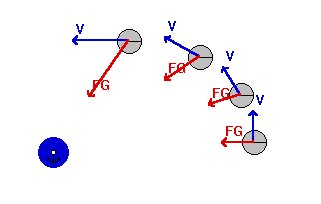 ... which, of course, it doesn't
do. The reason is the second factor in our Moon's forward
momentum (its inertia, Newton 1). For simplicity we keep Earth in
our drawings at rest now, which, strictly speaking, is not correct.
... which, of course, it doesn't
do. The reason is the second factor in our Moon's forward
momentum (its inertia, Newton 1). For simplicity we keep Earth in
our drawings at rest now, which, strictly speaking, is not correct.
In the figure, look at one Moon image at a time: velocity v
is forward, gravitational force FG is always directly
towards
Earth. This force changes the direction of motion to the left,
getting
our Moon into an orbit. As our Moon gets closer to Earth, FG
gets larger.
To compare forward velocity with gravitational force (i.e. acceleration), we do a couple of calculations:
So the gravitational influence of Earth is not sufficient to make our
Moon crash onto Earth's surface. But it is large enough to make
our Moon orbit Earth. Our Moon is therefore falling around Earth,
so to say.
The same situation applies to Earth as we orbit our Moon, just with
a different speed and acceleration.
The orbit of the Space Shuttle.
The Space Shuttle orbits at altitudes of 200 to 300 miles ,
which is about 1.1 times farther from Earth's center then we are.
The Space Shuttle orbits Earth for the same reasons our Moon
does. It covers the
26,000 miles in 1.5 hours with a speed of about
5
miles/sec and an acceleration due to Earth's gravity of 26
ft/s 2 . In 1
second it progresses 5 miles
but falls by only 13 feet .
Earth's gravitational influence on an Astronaut who "feels weightless" inside the Space Shuttle.
According to the gravitational law Space Shuttle and Astronauts experience a gravitational force and acceleration about 1.1x1.1 times weaker , i.e. about 26 ft/s2 instead of our 32 ft/s2 . Since our weight depends on the acceleration due to gravity, an astronaut will feel about 20% lighter.
What does this mean? It means that an astronaut has about 80% of his normal weight (of course, his mass is the same), and thus we speak carelessly about "weightlessness". A newer term is coined "micro-gravity", but either one pretends that there is no or very little gravity. But we have seen that this is not true: gravity is almost as strong as on Earth's surface, certainly not negligibly small.
So what's going on?
Ask a parachutist or remember when you jumped from that dreaded 10 feet tower: you seemed to feel weightless. Instead you were in "free-fall". That's exactly the same for the Space Shuttle and the astronauts as they are in free-fall around Earth. And therefore they "feel" weightless.
Look at this USPS stamp panel and figure out why the headline "Escaping the Gravity of Earth" does not fit the picture of the space shuttle, the astronauts, and the earth in the background. Send me an e-mail with your comments.
For a description of free fall see David Stern's From Stargazers to Starships web site at NASA .
Tides and tidal forces
Day and Night
Earth needs 23 hours 56 minutes for one
rotation (links
don't work ). In this amount of time, Earth also
orbits a little further, about one degree (it needs 365 days to orbit
360 degrees - so that's about 1 degree per day). So Earth needs
another 4 minutes for the Sun to
be in the same spot. And that's what we call the length of a
day. Just as with Mercury, Earth's length of day depends on its
rotation and its orbital period, but much more on its rotation.
Seasons
Due to the tilt of the Earth's axis (23.5 degrees) as it orbits the Sun, the amount of daylight and -heat is different and the Earth absorbs more or less sunlight depending on the angle that sunlight strikes and on the length of the day (both depend on the tilt of the axis). This causes the seasons.
 (2
MB gif - animations) and calendar pictures of January 4 and July 4
(2
MB gif - animations) and calendar pictures of January 4 and July 4
Seasons have absolutely nothing to do with the Earth being closer or farther from our Sun!
In fact, distance varies only from 91.5 to 93.5 million miles during a year - not enough to have an effect on seasons. (Imagine standing 5 feet away from a fireplace. Now move 1 inch closer - notice any difference? Neither does Earth when we are closest in early January.)
Seasons have absolutely nothing to do with the Earth-Sun distance, which varies by 3%. This means that the Earth theoretically receives 6% more sunlight and heat in winter - that's when we are closest to the Sun.
In winter?
Yes, right! OUR (northern hemisphere) winter, which is Australia's
& New Zealand's, Southern South America's, Southern Africa's, and
Antarctica's SUMMER.
While we have summer, they have winter. Our fall is their spring. Etc.
So that can't be it.
One could argue that one hemisphere is a little closer, since it's
tilted towards the Sun. But by how much closer? About 2 thousand miles
- compare that to the total distance of 93 MILLION miles - that's a
difference of only 0.002 % - no way that could account for seasons
either.
Instead, the Earth's tilt (of its axis) produces two other effects:
It accounts for the Sun's height above the horizon - the Sun is higher
in
the summer and lower in the winter, right? Therefore the Sun's light
hits
Earth at a more favorable angle (higher - summer) and more light and
heat
are absorbed - or less favorable angle (lower - winter) and more heat
and
light are reflected back into space.
The axis' tilt also accounts for the length of a day. Shorter days in
winter mean less sunlight received.
Two viewpoints: The Earth's axis is "fixed" in space (it always points toward Polaris) as we revolve around the Sun. Therefore, with respect to the Sun, the axis (e.g. the North Pole) points towards the Sun - summer. Or it points away - winter. Or it points neither toward nor away - spring and fall.

Foxtrot, (c) Bill Amend. This strip was printed in newspapers on December 2, 1999, a typical day during an unusually warm fall that year.
 .....
..... 
The photos show a model of Earth's distance to our Sun (the water
tower that the arrow points at) in January (left) and in July
(right). The point is that in this model, the water tower is
about a mile (5000 feet) away while the globe is moved by about 100
feet. Whatever amount of "heat" received by the globe from the
tower is basically the same during either
season. But notice that the Northern hemisphere is tilted away on
the
left (our winter) while tilted towards on the right (our summer).
And here is another - of course, yet very similar - take on seasons that I wrote:
One could just say that it’s warm and thus summer when we’re close to our Sun and cold and thus winter when we’re far away. That explanation makes sense but it’s wrong.
It’s not correct because Earth has its closest approach to our Sun at 91.4 million miles around January 3 and is farthest at 94.5 million miles around July 4 (the average distance being 93.1 million miles). We can check this in any good astronomy book, google “perihelion and aphelion”, or make our own observations: take photos of the Sun in early January and in early July (on second thought I don’t recommend that because it’s dangerous; but visit http://www.perseus.gr/Astro-Solar-Scenes-Aph-Perihelion.htm [see image below] instead or image-google “sun size perihelion aphelion”) and on first sight you don’t see any difference in size – thus same Earth-Sun distance during either month and ergo, that can’t be the reason for the seasons; on second inspection, the Sun’s size is ever so slightly larger in January, thus closer, thus closer in winter – ergo, contrary for the seasons. (This is of course caused by Earth’s elliptical orbit which perpetuates this wrong explanation. However, as explained, the difference is minimal and even placed in the wrong season. The Earth’s ellipse around the Sun is virtually circular, giving rise to very little differences in distance.)
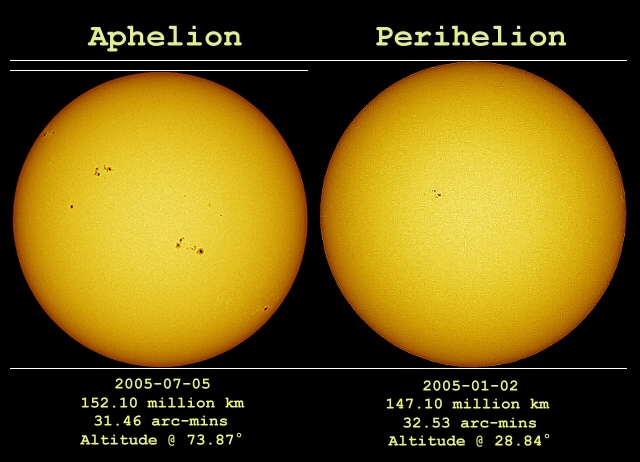
Another strike against the distance hypothesis is that the Northern and Southern hemispheres have opposite seasons at the same time, e.g. the Australian Open in Tennis, always being played in January, with players battling the typical 90 to 110 F mid-summer temperatures, and the World Cup in Soccer is played in June 2010 in South Africa with typical 50-70 F mid-winter temperatures (they have more mild temps in winter because they’re closer to the equator, just as Texas and Mexico are).
A third strike against the distance hypothesis is that it doesn’t explain what we actually observe throughout the year: in winter the Sun makes a small, low arc across the Southern horizon for a short time, while in summer it makes a large, high arc across most of the sky for a long time (we can see these different size arcs extremely well in Alaska and of course also notice a big difference between 6 hours of daylight in winter and 19 hours in summer). Again, we can’t explain these very familiar observations by invoking anything about a perceived change in the Earth-Sun distance.
Instead, seasons must be explained differently: it’s the tilt of Earth’s axis that produces them.
In order to understand seasons, model them by using a bright lamp and an Earth globe (note that all globes are always manufactured with the correct 23 degree tilt) in a darkened room. Position the globe about three feet from the lamp, so that the Northern part of the axis is tilted towards the lamp and also points at the top shelf of your book case. That top shelf shall substitute for Polaris, the North Star, towards which Earth’s axis always points. Notice that the Sun (the bright lamp) shines more directly onto the Northern hemisphere (the Sun appears higher and its radiation is more intense) and when you rotate the globe that we get long hours of daylight and thus long hours of heat: it is summer. (Look at the Southern hemisphere: low Sun angle, short days.) Now make the Earth orbit half way around the Sun with the axis pointing at the top shelf and keeping a distance of about three feet. On the opposite side, the Earth’s axis is now pointing away from our Sun. We get sunlight under a much more shallow angle (which produces a lower arc) and again, when you rotate the globe, you can see that we get few hours of daylight and thus few hours of heat: it is winter. (Notice that the Southern hemisphere gets more direct Sun and longer days, thus it is summer for them.) Fall and spring are in between these extremes.
In summary, the reasons for the season are: Earth’s constant tilt of axis in space; Earth orbiting the Sun, thus the axis points - relative to the Sun - towards, respectively away from it; this produces long, respectively short hours of daylight and heat; and this produces high arcs and intense sunlight, respectively low arcs and shallow sunlight.
Seasons: winter on the left (in the Northern hemisphere) as Earth's axis points away from the Sun; summer on the right (in the Northern hemisphere) as Earth's axis points towards the Sun.
Scale: the Earth and Sun sizes are totally off. The Sun is 1000 times larger than the Earth - in diameter (865,000 vs. 7900 miles). But if I chose the correct scale, the Earth in this drawing would be the size of a period - and that would defeat the purpose of explaining the seasons.
Scale again: the Earth-Sun distance is totally off as well. That distance is 67 times more than the Sun's diameter (93,100,000 vs. 865,000 miles) and thus - if the Sun in this image was printed with a 1 inch diameter - the Earth on either side would be 67 inches or 5.5 feet away. And the newspaper isn't that large.
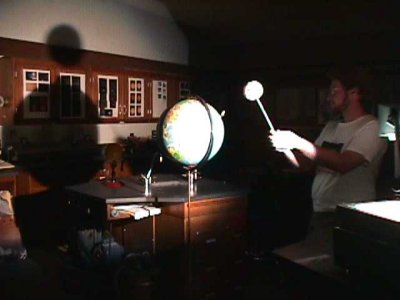 ...
... 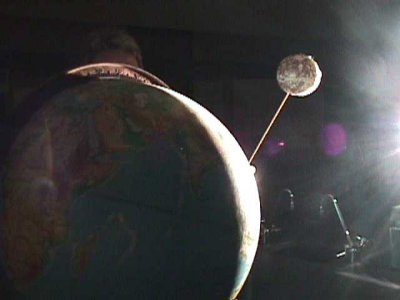
Phases depend on the geometry of Sun, Earth,
and our Moon. Notice that half of our Moon is always lit-up!
During full Moon we see the entire lit-up half of
our Moon, during quarter Moon we see half of the lit-up half (i.e. one
quarter), during new Moon we don't see the lit-up half at all.
The photos of the model show a crescent moon as
such because we are only able to see very little of the lit-up half of
our Moon.
Our Moon's phases have absolutely nothing to do with any body's shadows!
Check Virtual
Reality Moon Phase Pictures and San Diego Plastics
. Animations:
University of Wisconsin (excellent!); calvin.edu
; Western
Washington University ;
Solar and Lunar Eclipses
 |
 |
 |
 |
 |
| Solar Eclipse in the Caribbean, February 26, 1998. (c) Jamalee and Dan Clark, Scottsbluff, NE. | Solar Eclipse in Europe, August
11, 1999. (c) Andreas Veh, Scottsbluff, NE. |
(six 200 kB gif - animations) | (2.2 MB gif - animation) | (700 kB gif - animation) |
(six 200 kB gif - animations) The
plane of our Moon's orbit is tilted to the Earth's orbital plane (by 5
degrees). Our Moon crosses the Earth's plane twice every month, but
only every half year are these two crossings exactly between Sun and
Earth (Solar eclipse) and "behind" Earth (Lunar eclipse). At all other
times during new or full moon does our Moon orbit too "high" or too
"low".
(2.2 MB gif - animation) Solar
eclipse: Our Moon is small compared to Earth. Therefore the shadow
of our Moon covers only a small path on Earth: twice every year
somewhere in the world, but the next time in North America will be
August 21, 2017, between 9 a.m. and 12 noon (total darkness lasts only
3 min), depending on the time zone you're in.
(700 kB gif - animation) Our Moon
covers the Sun as seen from Earth.
Other animations: University of Tennessee
top view , 94
USA annular (view from Sun , 95
Indonesia (view from Moon) ; a photo of the
December 4, 2002 total solar eclipse on the Indian ocean, taken from
space by ISS astronaut Don Pettit.
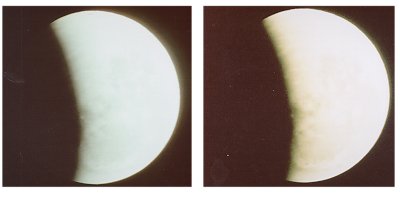 |
Lunar eclipses: Earth's shadow covers our Moon either entirely or partially. These occasions can be observed much more frequent than solar eclipses from a given location: In North America on Sep. 27, 1996; Mar. 24, 1997; Mar. 13, Aug. 8 & Sep. 6, 1998; Jul. 28, 1999; Jan. 20, 2000; July 31, 2000; Dec. 30, 2001; May 26, 2002; Nov. 24, 2002. My animation with frames every 15 minutes; University of Tennessee ; Akira Fujii's spectacular photo of a lunar eclipse - I absolutely love this photo because it leaves no doubt that the Earth is round (after all its shadow is). Another great animation at LIVE! ECLIPSE . |
|
|
Size:
|
||||||||||||||||||||||||||||||||||||||||||||||||
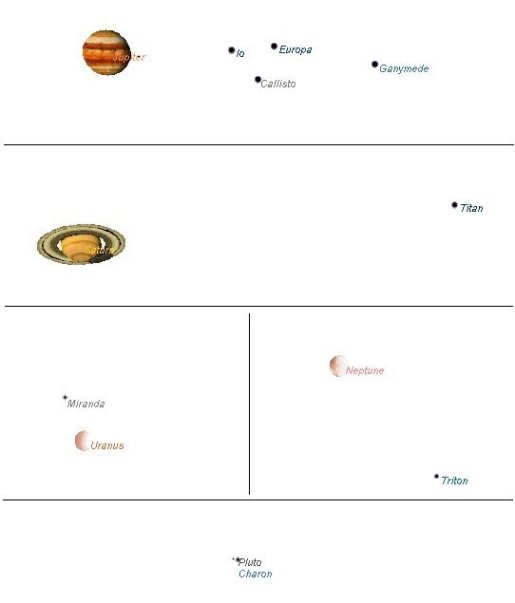 |
- Proxima Centauri (the closest star, plum-size) is 800 miles away (see you in Chicago?). Get people to scatter around in the yard (don't line up since planets usually don't line up either) to form the solar system. If you want to know where the inner and outer planets are right now: Fourmilab . Approximate positions make the solar system model more realistic. One of many scale models exists in Peoria, Illinois . If you want to use the accompanying diagrams of planets and Sun, you'd have to double each distance. |
Note that Kepler's Laws are not only valid for the Planets orbiting the Sun, but for the Moons orbiting their respective Planet as well as Satellites, Comets, Asteroids, and Meteorites in Orbits around Planets, Moons, and Sun, as well as planets orbiting other stars (our Sun is just one ordinary star), binary stars orbiting each other and stars and star clusters orbiting the center of galaxies.
1. A Planet orbits our Sun on an Ellipse.
 .....
..... 
The diagram shows the orbit of Neptune's moon
Nereid and how far it orbits in one month, far from Neptune and close
to Neptune. The photos show the instructor rotating on a swivel
chair, holding a weight. He turns faster when he gets the weight
closer to his body (notice the smeared out image of his pants).
Animation:
University of Tennessee .
Note that the second Law describes each Planet individually, while the third Law compares all Planets with each other.
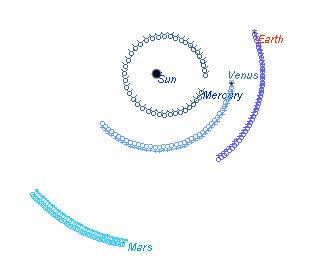 |
3. Distance and Period
of a Planet are related: their Fraction (i.e. Distance cubed to
Period
squared) is the same Constant for all Planets. This Constant
contains
the central Object's Mass. Animations:
Western Washington University ; Research a couple web sites to find some illustrations that make Kepler's laws more visual. Central Valley Christian High School, Visalia, CA Find a table that shows the planet's distances and periods and confirms Kepler's 3rd. And find a table on a planet's moons that also confirms Kepler's 3rd. |
I like to wear self-made t-shirts to class on which I ironed images
connected to the content:
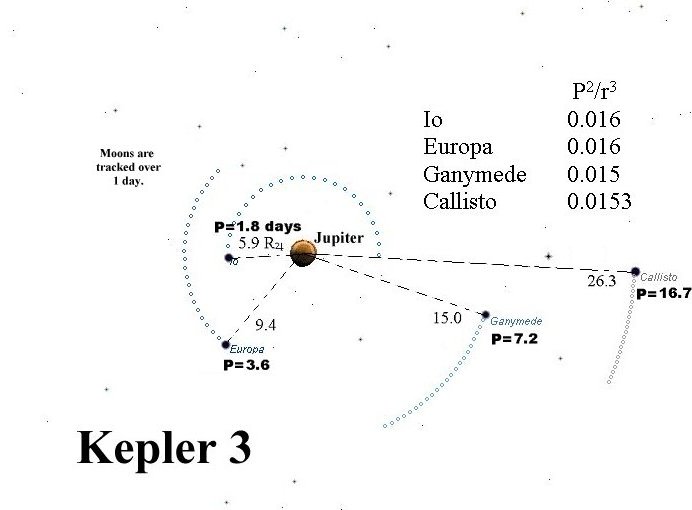

 (Jupiter being retrograde
in Sagittarius in 1996, see
Lab K1 .) As seen from our vantage point (Earth), all
planets, Sun, and our Moon move West-East as seen from day to day along
the ecliptic, which runs through the Zodiac constellations.
(Jupiter being retrograde
in Sagittarius in 1996, see
Lab K1 .) As seen from our vantage point (Earth), all
planets, Sun, and our Moon move West-East as seen from day to day along
the ecliptic, which runs through the Zodiac constellations.
But once in a while a planet seems to move backwards (retrograde). This
happens when we are passing an outer planet or Mercury or Venus passes
us.
An analogy: Imagine that a Ferrari is traveling down I-80 (very straight, level interstate in NE) on the right lane at 40 mph. You're in your Landrover on the left lane with 60 mph, about to pass this slowpoke. Focus on this Ferrari (why not?) and you notice that it "seemingly" moves backwards (against the background such as trees or prairie) while you pass it. When you're at an appreciable distance again, the other car will again seem to move forward (as it did the entire time anyway).
Exactly the same thing happens when we (on fast Earth at 19
miles-per-second!) pass Mars (at 15 mps) or Jupiter (at 8 mps),
etc., which are moving forward all the time. But as we pass them,
they seem to move backwards (against the background of
the stars) for a while - retrograde motion.
Check out this cool animation from the University of Tennessee , click on the Retrograde motion applet.
Do my online labs on Jupiter and Mars . For Mars you will see that it also becomes much brighter as it moves retrograde - because it's so close as we pass it.
You can check your results for Mars' motion using Nick Strobel's diagram of Mars' motion from November 96 to August 97 (towards the bottom).
Animations: University of Tennessee ( outer space view ) and ( Earth based view ); Andy Veh (mine) ; Pikeville College ; Kent State University (geocentric); Physics Nova Scotia ; University of Oregon (geocentric); The Ross School ;
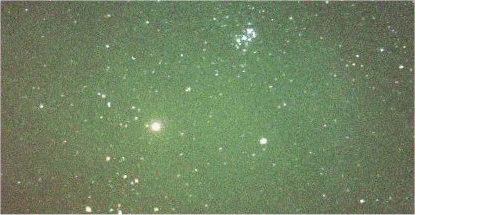
![]()
Coordinates on Earth are Longitude and Latitude:
Greenwich (London) / England 0 W 51 NStars, Galaxies, Planets, Comets, Asteroids, etc. have four coordinates:
Scottsbluff, Nebraska / USA 103 W 42 N
Berlin / Germany 13 E 53 N
Melbourne / Australia 155 E 38 S
South Pole / Antarctica --------- 90 S
The Equatorial SystemPlanets and Comets have no constant R.A. and dec, since they are "wanderers" = planets (Greek) in the sky. Instead their ephemerides are listed in catalogs.
Right Ascension (Longitude) (in hours) } always
Declination of stars (Latitude) (in degrees) } the same
R.A. dec
Altair 19h 45m + 9
Aldebaran 4h 35m + 16
Procyon 7h 40m + 5
Arcturus 14h 15m + 19
The Horizon systemWhy all these definitions for coordinates and times?
Azimuth (from North clockwise 360) } changing throughout
Altitude (from 0 Horizon to 90 Zenith) } night, year, and location
Aldebaran (Jan. 16, 2000 - 18:00 MST, New York) Az. 154 Alt. 64
(Jan. 16, 2000 - 18:00 MST, Scottsbluff) Az. 113 Alt. 47
(Jan. 16, 2000 - 18:30 MST, Scottsbluff) Az. 122 Alt. 52
(Jan. 23, 2000 - 18:30 MST, Scottsbluff) Az. 131 Alt. 56
Universal Time (Naval Observatory) = Greenwich Mean Time (0 Longitude, suburb of London)
Local Time is our "normal" time (without Daylight Savings Time)
Local time minus U.T. is the Time zone
(Example: Scottsbluff is at 103 Longitude, i.e. MST - UT = - 7 h)
Sidereal Time
Julian Date - July 1, 2000, 0h UT J.D. = 2 451 726.5 , counting one up every day
Astronomy is a hobby and science that is done throughout the world with people looking at the same sky at the same time. Since the same sky appears shifted from one location to another, one had to assign coordinates. In order to compare observations with each other, people agreed to a common time (U.T. in Greenwich). It makes communicating observations much easier and efficient.
Coordinates (Equatorial and Horizon) of major bright
stars and Ephemerides of planets, Sun, and our Moon are still published
in Nautical Almanacs. Knowing and predicting positions of stars,
planets,
Sun, and Moon has been a crucial and contributing science throughout
mankind's history of exploration. It made navigation and
exploration (and
survival!) possible.
A moving body (solid, liquid, or gaseous)
on the rotating Earth tends to veer sideways. Emphasis is on "moving
body"
and "rotating Earth". Without one or the other, the Coriolis force (the
"veering") is zero.
Assume a baseball pitcher standing in the middle of a
large rotating platform, throwing the ball to the catcher standing on
the rim. If
the platform stands still, the catcher catches the ball (no rotation -
no
Coriolis force). If the platform rotates (e.g. to the right -
clockwise), and again the pitcher throws towards the catcher - then,
while the ball is in midair, the platform rotates further taking the
catcher along - and he won't catch it (moving ball and rotating
platform made the ball veer to the left).
Although we are usually not aware that our Earth
rotates, moving bodies do veer sideways, because the Earth really does
rotate.
Assume standing somewhere in the Northern hemisphere -
the Earth turns "counterclockwise", so bodies veer to the left. Now
assume
standing in the Southern hemisphere - the Earth seemingly turns
"clockwise",
so bodies veer to the left.
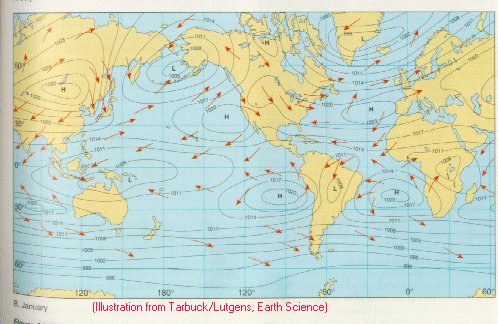
The air emerging from a High pressure system in the Northern hemisphere veers to the right (clockwise). Air flows into a Low counterclockwise. In the Southern hemisphere, a High is counterclockwise and a Low is clockwise. (Illustration from Tarbuck/Lutgens, Earth Science) |
2. Ocean currents 
Currents in the World oceans (Pacific,
Atlantic, Indian) turn the same way as winds do. |
3. Hurricanes and Tropical Cyclones 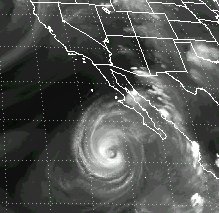 These are large enough weather systems that they
are strongly affected by the Coriolis force. Hurricanes in the Northern
hemisphere
rotate counterclockwise, Tropical Cyclones in the Southern hemisphere
rotate
clockwise. These are large enough weather systems that they
are strongly affected by the Coriolis force. Hurricanes in the Northern
hemisphere
rotate counterclockwise, Tropical Cyclones in the Southern hemisphere
rotate
clockwise.Tornadoes are much too small in comparison, so that any preferred direction of spin could yet not be linked to the Coriolis effect. The upper image shows hurricane Linda off Mexico's West coast (from NASA's GOES satellite, Sept. 14, 1997). An image of a tropical cyclone off Australia's West coast (from Michael Bath's home page ) appears below. Compare the images.
|
4. Foucault pendulum |
5. Projectiles From Jearl Walker's The Flying Circus of Physics: During World War I, there was a famous British-German naval fight near Falkland Islands (about 50 degrees South latitude) in which British shots, while well aimed, were mysteriously landing about a hundred yards to the left of the German ships. The British gun sights were not faulty, for they had been set very precisely back in England. During the German shelling of Paris in the same war, a huge artillery piece called Big Bertha would pump shells into the city from 70 miles away. If normal aiming procedure has been employed, Big Bertha's shots would have missed their mark by almost a mile. What was happening to the shells? |
| 6. Worn-out railroad tracks The left rails of North-South running railroad tracks should be worn out more, provided trains run only in one direction (otherwise both rails will be worn out the same). -- In 1995, a book or journal called Essays In Science published the article "The Cause of the Formation of Meanders in the Course of Rivers and the So-Called Beer's Law", saying that (again Jearl Walker) "the right bank of a river in the Northern hemisphere suffer[s] more erosion, on the average, than the left bank". The article was written by A. Einstein. |
7. Sinks, toilet bowls and baseball The above example of pitching and catching was an analogy. In reality, the baseball is not affected by the Coriolis force. But since the distance pitcher-catcher and the time for the ball to fly are so small, the ball veers by perhaps a thousandth of an inch, which is too small to influence the game of baseball. ----- The same holds for arrows and bullets. For long-range projectiles see above. ----- Popular belief has it that one could show the Coriolis effect by letting water run out of a sink, a bathtub, or when flushing a toilet. Again, the scale is so small (compare the above examples) and water leaves the sink so fast that the Coriolis force hardly affects the moving water at all. Instead, the shape of the sink and the drain, the way the plug is pulled, make it spiral one way or the other. -- Here's a challenge for people who plan a trip to a country in the other hemisphere (North or South): Take a couple of different buckets or bowls. Drill a hole into the bottom. Let water run out and repeat many times. Record the direction of spiral and determine any preferential motion. -- Now take the SAME buckets, travel to the other hemisphere and repeat this. If the preferential spiral is in the opposite direction, you have shown the Coriolis effect on a small scale. |
Appendix
...